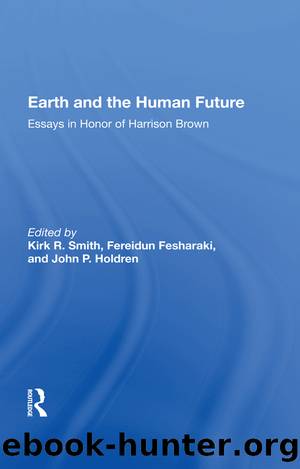Earth And The Human Future by Kirk R Smith

Author:Kirk R Smith [Smith, Kirk R]
Language: eng
Format: epub
Tags: Social Science, General, Sociology
ISBN: 9780429705656
Google: iGwPEAAAQBAJ
Publisher: Routledge
Published: 2019-09-17T03:49:17+00:00
Poor People in Rich CountriesâThe Problem of Energy Costs
The industrial nations, rich on the average, display distributions of wealth and income that leave the poorest members of these societies seriously disadvantaged in absolute terms. In the industrial market economies as a whole, for example, the average income per person in the poorest one-fifth of the population is less than 30 percent of the average figure for these societies as a whole; in the United States, about one-tenth of all households have incomes of less than 25 percent of the national average. These lower economic classes bear a particularly heavy burden when energy costs are high. This part of the predicament of the poor has several dimensions.
First, the fraction of income consumed by direct expenditures on energyâthat is, residential energy use plus automotive gasoline purchasesâis much higher for the poor than for the economically well-off By the end of the 1970s, direct energy costs for the poorest 5 percent of U.S. households were about 30 percent of income. For families in the middle of the income distribution, by contrast, direct energy costs consumed about 10 percent of income. Obviously, energy costs are a major drain on the finances of poor families although still only a moderate one for the well-off Every increase in the price of energy will hit poor families much harder than it hits the rest, moreover, since the poor have so little room to cut back elsewhere in their budgets in order to pay more for energy.
A second dimension of the special energy problem of the poor is that they lack the money to make energy-conservation investments. Insulation and weatherstripping, the new, efficient appliances, and fuel-efficient cars are all out of economic reach for the poor, who tend to live in âleakyâ buildings, own secondhand appliances, and drive ancient gas guzzlers if they drive at all.
Third, the poor are especially vulnerable to the economic dislocations that rising energy costs create or aggravate. For example, the inflation to which rising energy prices have contributed hits the poor hard because they are often on fixed incomes or on welfare programs that have not grown apace with inflation. In addition, because the poor make up, in general, the least trained and least mobile part of the workforce, they lose their jobs first and stay unemployed when rising energy costs destroy the competitiveness of older factories or when more general recession (as in the wake of the 1973â1974 and 1979 oil-price hikes) reduces economic output overall.
Download
This site does not store any files on its server. We only index and link to content provided by other sites. Please contact the content providers to delete copyright contents if any and email us, we'll remove relevant links or contents immediately.
The Lonely City by Olivia Laing(4567)
Animal Frequency by Melissa Alvarez(4148)
All Creatures Great and Small by James Herriot(3983)
Walking by Henry David Thoreau(3681)
Exit West by Mohsin Hamid(3634)
Origin Story: A Big History of Everything by David Christian(3471)
COSMOS by Carl Sagan(3346)
How to Read Water: Clues and Patterns from Puddles to the Sea (Natural Navigation) by Tristan Gooley(3239)
How to Do Nothing by Jenny Odell(3101)
The Inner Life of Animals by Peter Wohlleben(3099)
Hedgerow by John Wright(3096)
How to Read Nature by Tristan Gooley(3077)
Project Animal Farm: An Accidental Journey into the Secret World of Farming and the Truth About Our Food by Sonia Faruqi(3016)
Origin Story by David Christian(2991)
Water by Ian Miller(2950)
A Forest Journey by John Perlin(2914)
The Plant Messiah by Carlos Magdalena(2745)
A Wilder Time by William E. Glassley(2687)
Forests: A Very Short Introduction by Jaboury Ghazoul(2671)
